SMALLER CARNIVORES
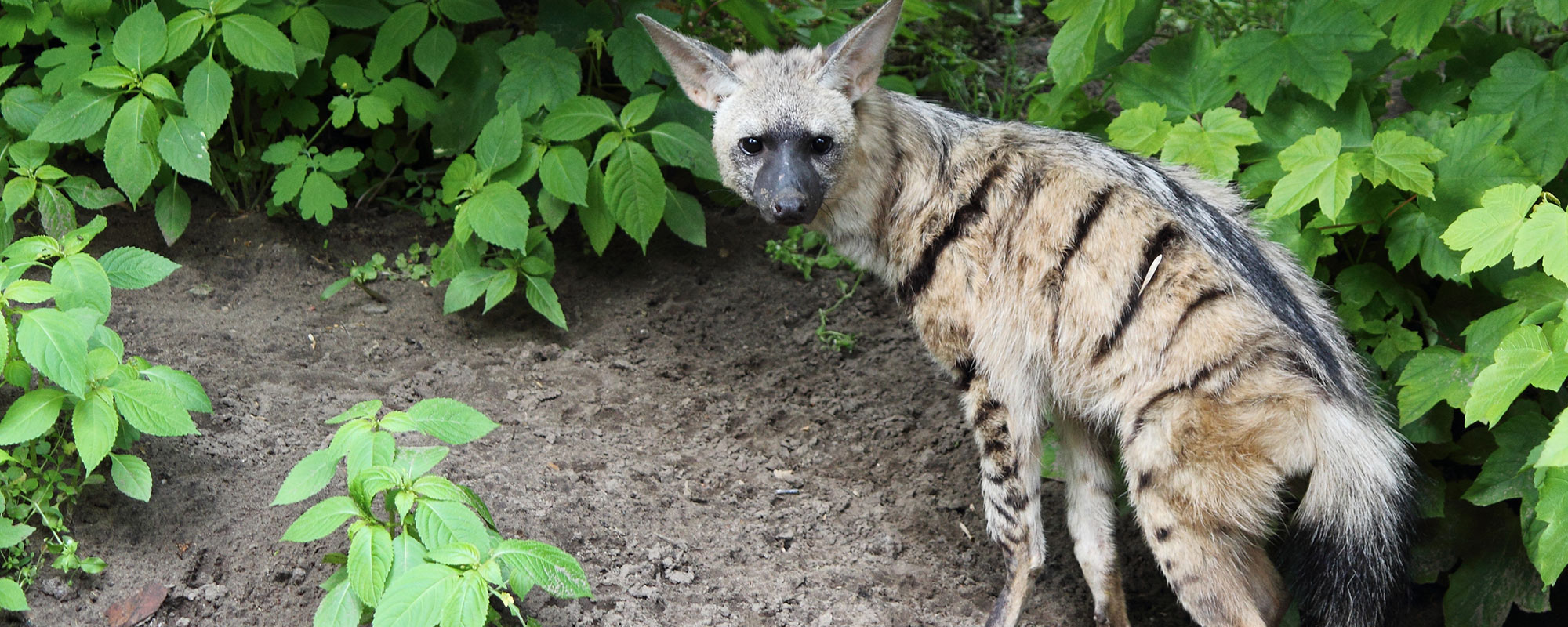
Aardwolf
Aardwolves are similar to the striped hyena in appearance but bushier. They are nocturnal but can sometimes be seen during the day. They favour open dry plains or light woodland where they feed on insects. Some experts suggest the aardwolf is related to the hyena but through a changing diet over the centuries, it has evolved into a family by itself. They move about at night, hiding during the daytime in old aardvark burrows in which they raise their young, usually three to a litter, often in small communities of nursing females.
AFRICAN WILD CATS
Similar in appearance to a large tabby cat, they occur throughout Zambia but are not often seen. They hunt at night, preying on small mammals, birds, frogs and insects. Their young are born in a hollow tree or burrow. African wild cats are fast runners and very successful hunters.
AFRICAN STRIPED WEASELS
Similar in marking to the zorilla, with the same white stripes down its back and a thick white bushy tail, zorillas are smaller, more slender and sleeker. They move in family groups or in pairs, feeding on rodents and small birds.
CARACULS
Present throughout the country but very rarely seen, the caracal is a beautiful cinnamon-coloured member of the cat family. They prey on small mammals and birds, have a gestation period of 10 weeks and live for as long as 17 years. Few cats can imitate the caracal’s sudden spring to pull down a bird in mid-flight, sometimes as high as three metres / 10 feet, a remarkable feat for such a small animal. The soft thick coat has no distinct stripes but is clearly spotted on the underside and has a shorter tail than any other African cat.
CIVETS
A civet can be described as a long-legged half dog-, half cat-like creature with long coarse body hair and a vivid pattern of black spots. They are fairly common in all Zambia’s wilderness areas, often seen on night drives in the national parks. During the day, they hide in thickets or holes and by night are omnivorous feeders. They return to the same place to defecate where they deposit large piles of dung (known as middens), showing the remains of beetles, fruit and a wide range of other food. They are very important disperses of fruit seeds. Their scent glands secrete a nauseating smell used to mark their territory. They gestate for six to nine weeks and live up to 14 years.
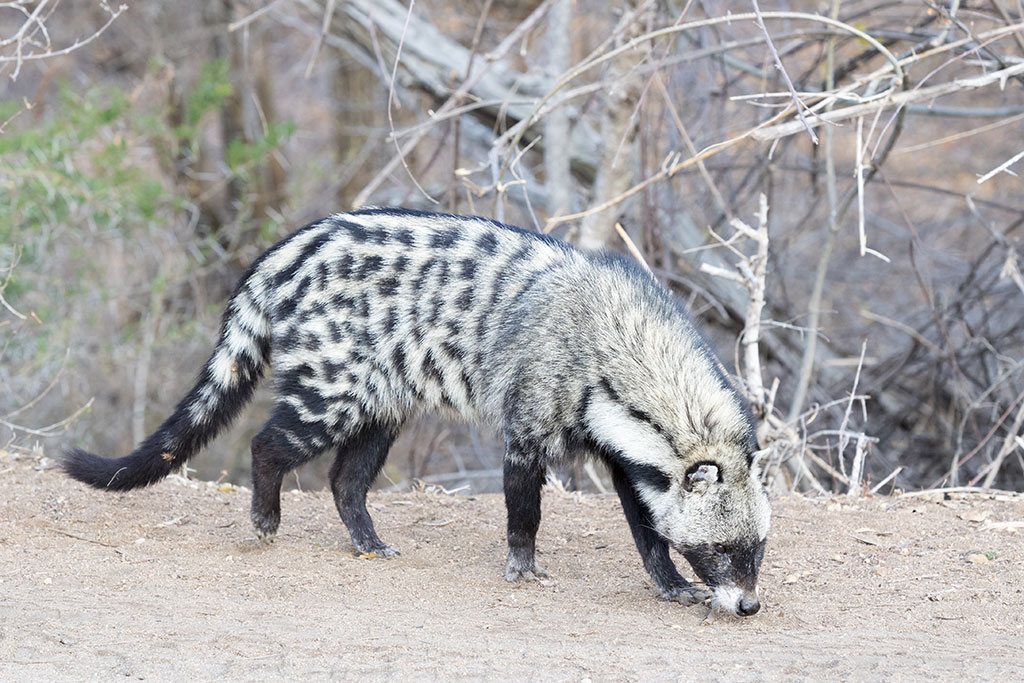
GENETS
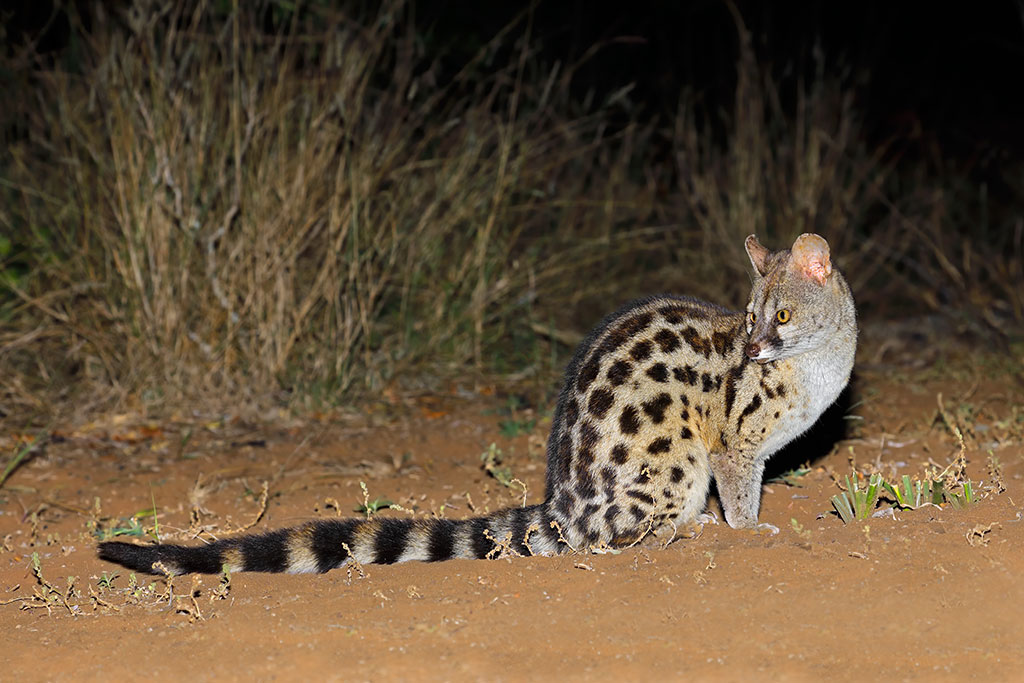
A small cat with short legs, pointed snout and ringed tail, genets are often seen at night in the wild. They live in trees where they breed, having two or three kittens per litter after a gestation period of two months and eat birds, mice, snakes and fruit.
Genets return to the same place day after day, hunting mostly on the ground. They spit and growl like domestic cats when they are angry or threatened. Their normal call is a clear metallic note.
Genets vary in colour from brownish-grey to pale yellow or buff with dark brown or black spots that tend to be large, elongated and arranged in rows along the soft-furred body.
They have a long tail ringed in black and white and a boldly patterned face. Like many other animals, the habitat determines the variations in colour, with species in arid areas having lighter-coloured coats than those in forested areas.
HONEY BADGERS
Very distinctive markings with a thick greyish white band from its head to its tail, the tail often held in an upright position, distinguish honey badgers. They are often in pairs and sometimes alone, living partly in trees and found in most habitat types. It preys on rodents and insects but also eats fruits, roots and honey.
Related to the wolverine and martens, as shown by the resemblance in teeth, the honey badger burrows and has the fierce disposition of the true badgers. It has short legs and stout claws and is a strong burrower and a good climber. About 61cm / 24in long excluding the tail, it has a coat that is black on the lower half of the body and pale grey above.
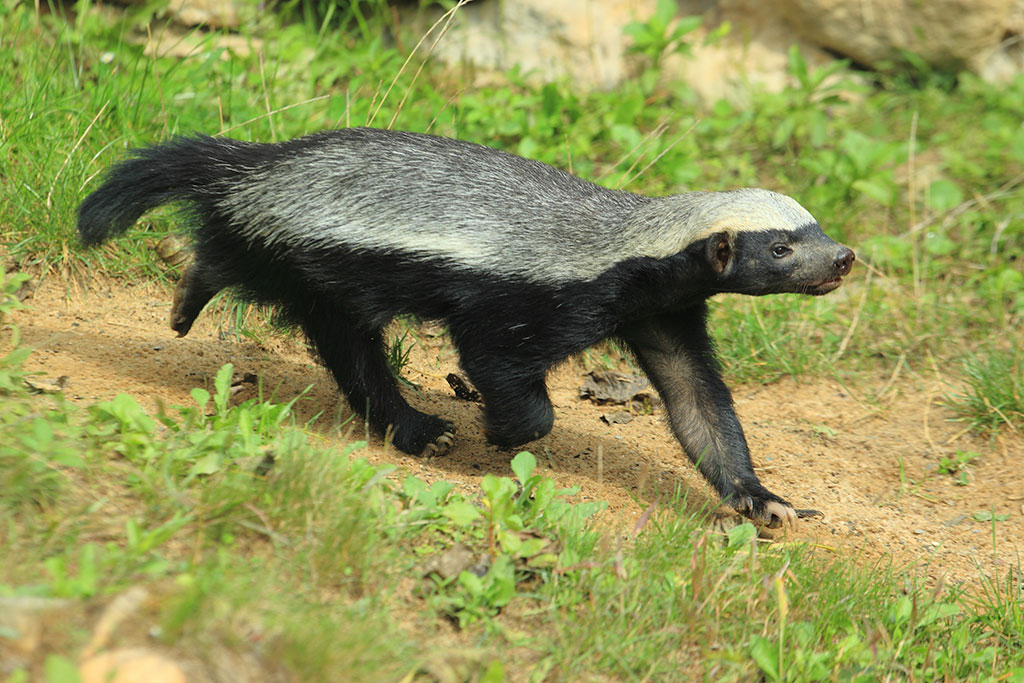
The honey badger resembles its distant relative the skunk in colouration and in the possession of an anal scent gland. It has a thick loose coat that protects it against snake bites and insect stings. The looseness of its skin also allows it to wriggle free of predators.
The name ‘honey badger’ is derived from its habit of collaborating with the honeyguide or indicator bird in obtaining honey, a favourite food. The bird searches for a bee colony and when one is found, the honey badger rips it open. The bird and the honey badger then share the honey. The young, usually two, are born in burrows. Honey badgers are omnivorous mammals, classified in the family Mustelidae.
MONGOOSES
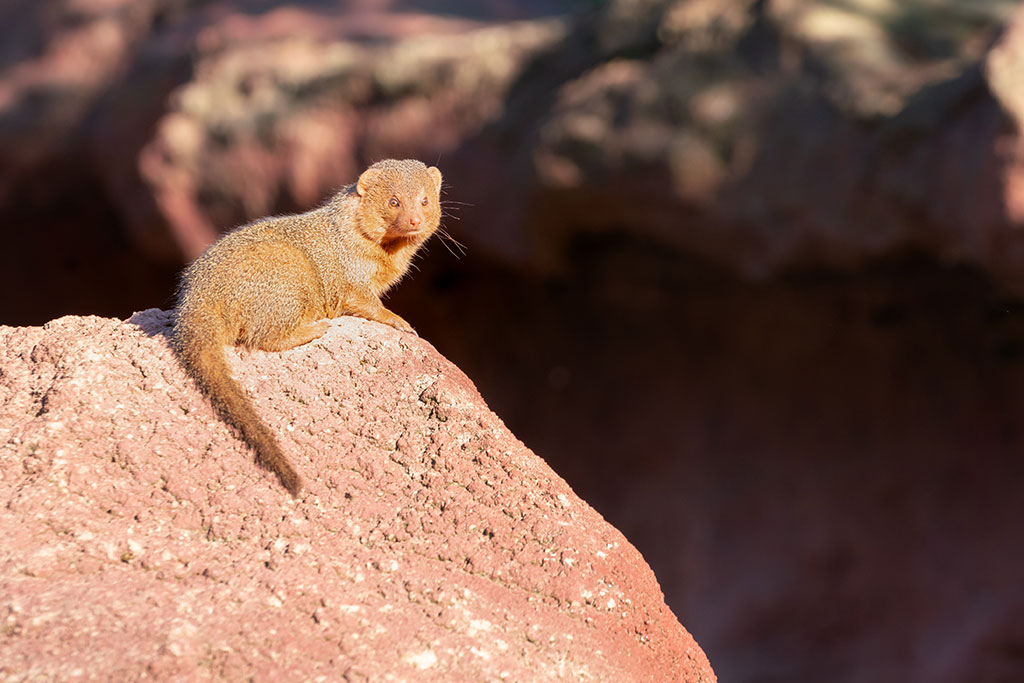
Nine species of mongoose occur in Zambia. The banded mongoose is the most conspicuous and is frequently seen actively foraging around in parties of a dozen or more. When disturbed, they scurry into termite mounds or other ground refuge. The slender mongoose is solitary and unmistakable with its upturned tufted tail. Found in various woodland types, it preys on small vertebrates and insects.
The white-tailed mongoose is a large nocturnal animal often picked up with a spotlight. The dwarf mongoose is the smallest in the family and runs in troops of up to 15. They are found in woodland near hollow trees, anthills or rocky outcrops.
A day in the life of a mongoose begins at sunrise. The adults come out of the den to warm up in the sun and groom themselves and each other, while the young wrestle and play around them. If the young are small, they stay at the nest site with a babysitter but if large enough to keep up with the pack, they all move off with the adults to forage for food. During the heat of the day the pack often returns to the den to rest. They forage again in the afternoon, and sun and groom themselves before returning to the den for the night.
Mongooses have keen eyesight and keep watch for potential predators and rival packs from the tops of termite mounds. They attack those that get too close or take the young mongooses to safety inside a termite mound. Even with such care the mortality rate is high for juveniles but considering their small size and the large number of potential predators (including snakes and raptors), mongooses have a remarkably long lifespan of around eight years.
SERVALS
Although fairly common in the bigger national parks, they are rarely seen. Looking like a large domestic cat with a spotted coat and a banded tail, the serval is a solitary animal breeding in the winter months. Their gestation period is two months, their young being born and reared in old anthill or porcupine burrows. They prey on small mammals, fish, lizards and birds and also eat fruit and roots.
The serval is much larger than the domestic cat. It is long-legged with the hind legs being longer than the front legs. Its neck is long and its head small, with large, erect ears.
The serval is mainly nocturnal but even in the daytime it can be difficult to see in tall grass. It hunts by sight and sound more than scent.
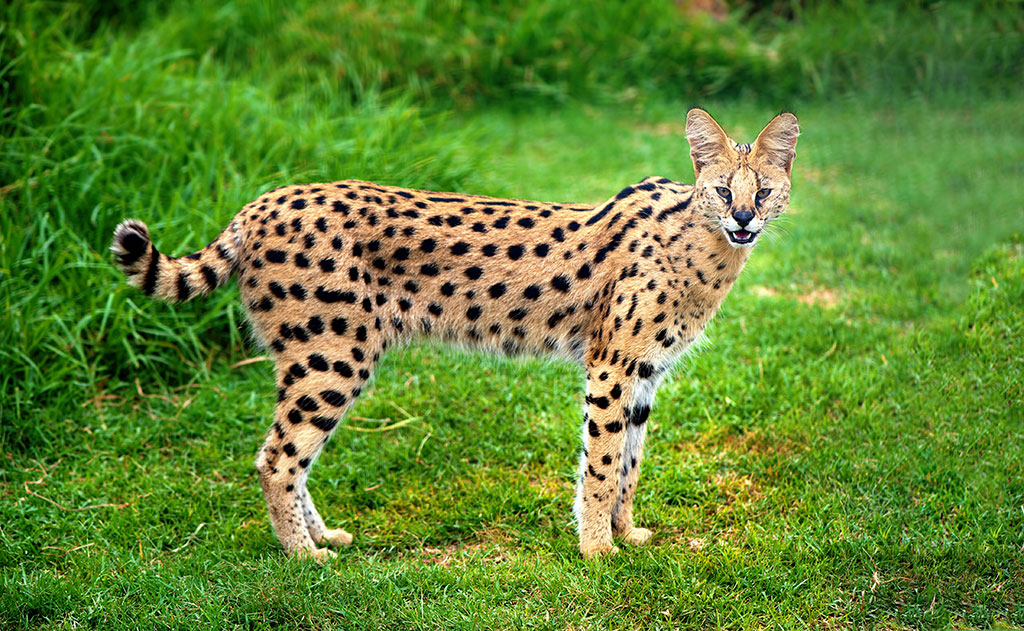
With its acute hearing, a serval can locate prey that is moving underground. If hunting prey above ground, the serval raises its head above the grass and listens for movement. Once a sound is located, the serval stealthily approaches, then leaps and pounces. It often plays with its catch before eating it. Servals are prey of hyenas, wild dogs and leopards.
OTTERS
The spotted-necked otter is moderate to small in size. Its head to body is 57cm / 22in. The tail is up to 45 cm / 17in long. The whole length of the spotted-necked otter is over one metre / three feet. Its feet are webbed, with the webbing ending close to the end of the toes, and it has strong claws. Seen occasionally along the Kafue River, this little chestnut brown creature moves in small family groups, occasionally alone and usually at night. It preys on fish, crabs and frogs.
The clawless otter is found in the larger streams and rivers of Kafue and Lochinvar and occasionally along the Zambezi River. It is larger than the spotted necked otter and, as its name implies, it has no claws and its front feet are not webbed.
JACKALS

The jackal, a medium-sized carnivore with doglike features and a bushy tail, is widely distributed in Zambia.
This animal has long been the subject of superstition about death and evil spirits. Such beliefs were probably encouraged by the jackal’s cleverness, nocturnal habits, eerie howling and scavenging.
Jackals live singly or in breeding pairs, and are sometimes found in small packs. They are among the few mammalian species in which the male and female mate for life. Mated pairs are territorial, and both the female and male mark and defend the boundaries of their territory.
Jackals can best be described as opportunistic omnivores. They co-operatively hunt small or young antelopes such as dik-diks or even domestic sheep.
They also eat snakes and other reptiles, insects, ground-dwelling birds, fruits, berries and grass. A pair of jackals will move through their territory at a fast trot, stopping frequently to examine something, sniff the air or listen-ready for any opportunity that might provide a meal.
Leopards, hyenas and eagles are jackals’ most feared predators. Eagles are small pups’ biggest threat.
ZORILLAS
The stripy zorilla has only been recorded in the Kafue National Park and is a rare sighting, favouring dry open country and light woodland, where it feeds on rodents, insects and small birds. The zorilla looks like a skunk but it is actually an African polecat, which is a different animal altogether. It produces a foul-smelling substance in its anal glands, which it can squirt out if it is threatened by predators or other dangers. A nocturnal animal, and it feeds on rodents, eggs, reptiles and insects. It spends the day resting in its burrow, which is found in the open country or savanna.
